IPO Unlocked: How Startups Go Public and What It Really Means
From Private Ambitions to Public Markets — A Complete Guide to the IPO Journey for Founders and Investors
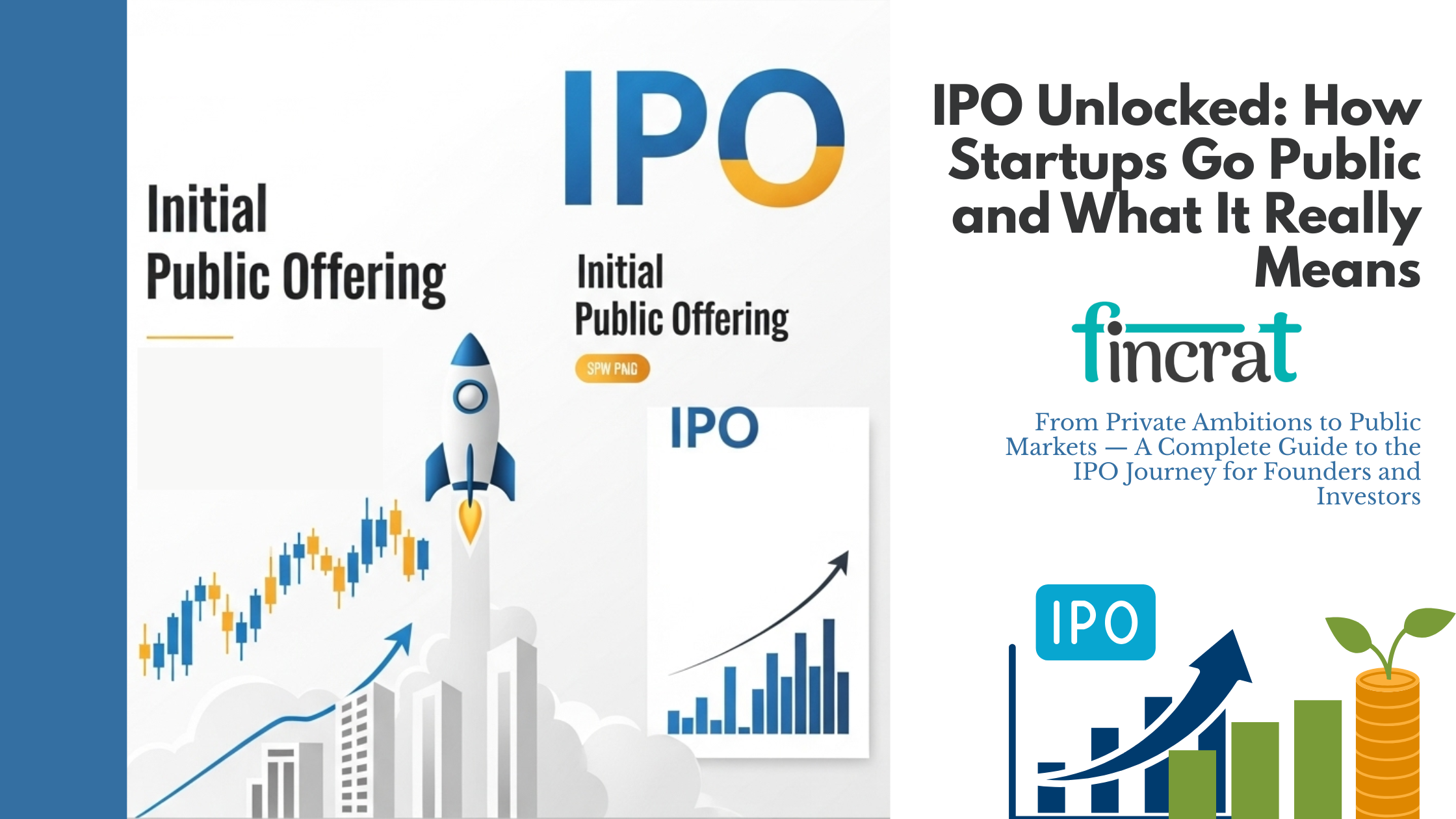
An Initial Public Offering (IPO) isn't just a funding event—it's a strategic transformation. For startups, it's the shift from being a private company with limited capital and visibility to becoming a public entity with access to global markets, institutional investors, and long-term growth capital.
But going public isn’t just about ringing the bell on NASDAQ. It’s about readiness—financial, operational, and cultural. Founders need to understand not just the benefits, but the regulatory hurdles, dilution trade-offs, and public market pressures that follow.
This guide breaks down everything you need to know—from what IPOs are, why startups pursue them, how they work, and what challenges come with the spotlight.
What Is an IPO?
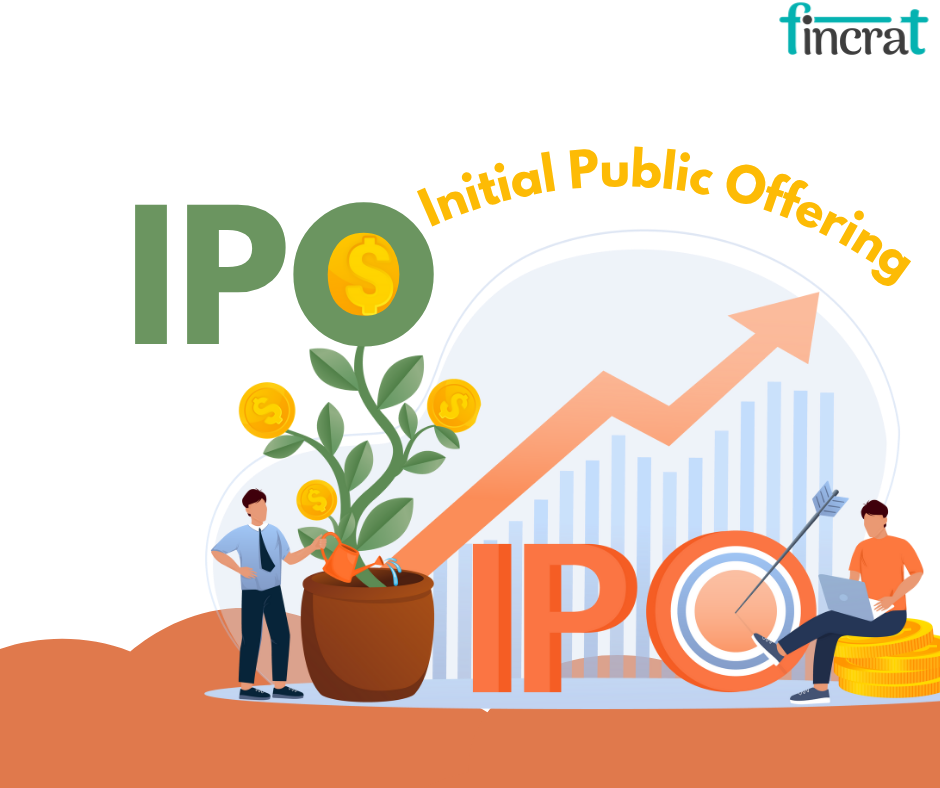
- An Initial Public Offering (IPO) is the procedure through which a privately owned startup transforms into a publicly traded corporation by selling its shares to institutional and retail investors on a stock exchange for the first time.
- This major milestone enables a company to fund enormous capital from the public markets and acquire credibility, visibility, and liquidity.
- IPOs are sometimes regarded as the best exit option for early investors and founders, converting private equity into publicly shareable stock
- IPOs usually happen between 6–10 years when a startup is initiated.
- For the U.S., the average IPO raises approximately $100 million.
- As of 2023, IPOs in the technology sector accounted for more than 50%-60% of total IPO volume worldwide.
- The world IPO market in 2022 experienced more than 1,300 IPOs, raising $179 billion in aggregate proceeds.
Why Startups Choose IPOs
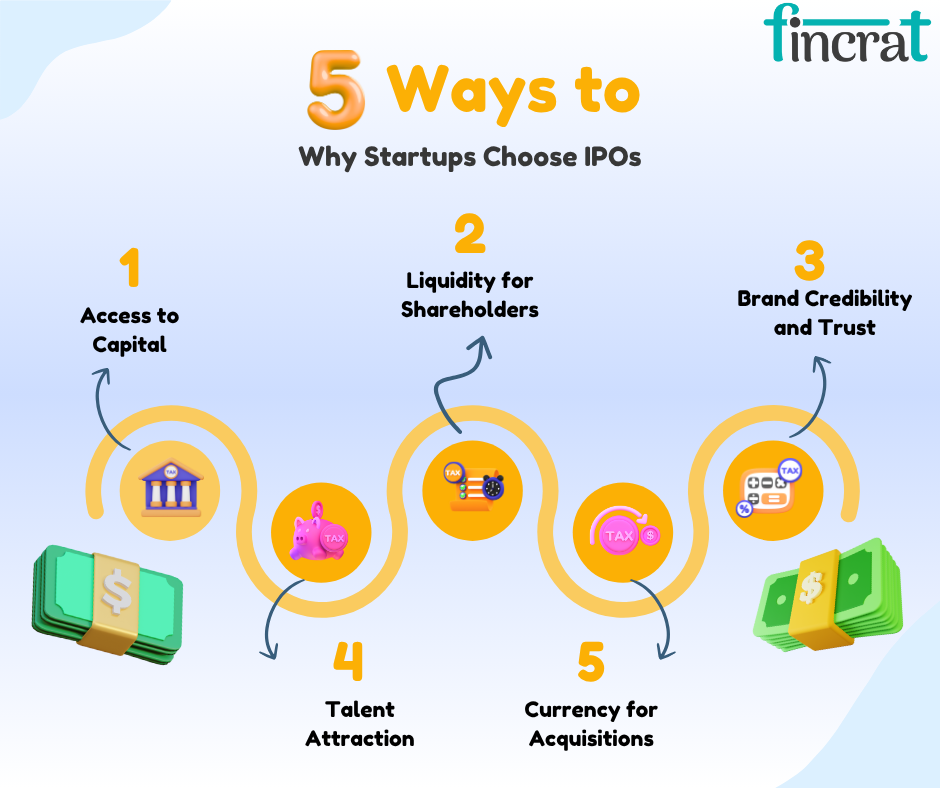
Startups go public for strategic reasons that extend far beyond money. An IPO represents maturity, scalability, and trust in the eyes of the public and investors. Here’s why they do it:
- Access to Capital: IPOs can raise millions—or even billions—of dollars in growth capital, which can be used to expand operations, enter new markets, invest in R&D, or acquire other companies.
- Liquidity for Shareholders: IPOs allow founders, early employees, and investors to sell part of their holdings and realize returns, although there may be lock-in periods.
- Brand Credibility and Trust: Being listed on a public exchange enhances the company’s reputation, visibility, and credibility among customers, partners, and the media.
- Talent Attraction: Public companies can attract top talent by offering stock options that have a clear path to liquidity.
- Currency for Acquisitions: Publicly traded shares can be used to acquire other businesses through stock-based deals.
The Key Benefits of IPOs
Let’s break down the top benefits startups enjoy when they go public:
- Huge Capital Infusion: Capital raised in an IPO usually swamps that raised in all prior rounds altogether. Such capital can be used to drive growth and market takeover aggressively.
- Exit Events: For investors, it's the much-desired "exit." For employees, vested stock finally is worth something in the public market. It's a win-win exit opportunity.
- Public Valuation: Markets give instant valuation feedback. Investors and stakeholders are now able to evaluate the true value of the company via share prices.
- Brand Positioning and Media Exposure: IPOs create national and international recognition. Being "public" is generally considered an indicator of success and credibility.
The IPO Process: Step-by-Step
Going public isn’t a sprint—it’s a structured marathon that involves advisors, regulators, investors, and the board. Here's how the process unfolds:
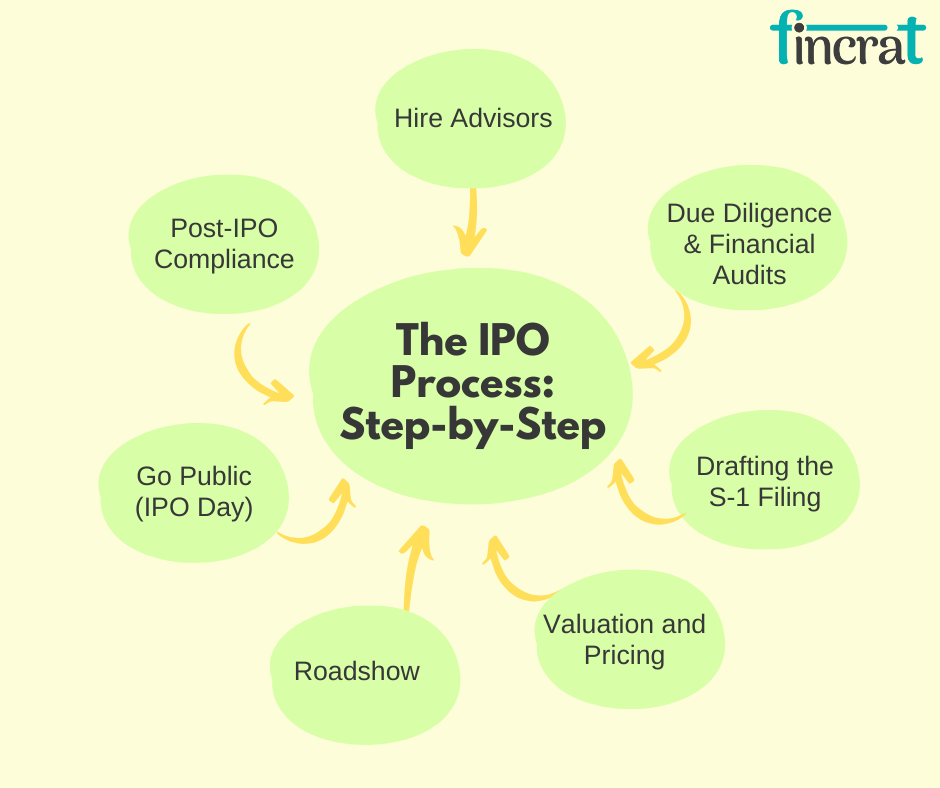
- Hire Advisors: The firm hires investment banks (underwriters), law firms, and auditors. The underwriters assist in the IPO format preparation and pricing.
- Due Diligence & Financial Audits: Auditors examine the company's accounting records, corporate organization, tax compliance, and legal status. Any conflicts have to be addressed prior to moving forward.
- Drafting the S-1 Filing (in the U.S.): A detailed registration form is filed with the Securities and Exchange Commission (SEC) with financials, risk factors, business model, executive bios, and shareholder information.
- Valuation and Pricing: The underwriters and the company assess market demand and determine the IPO share price, offering size, and anticipated valuation.
- Roadshow: Company executives travel the world to meet with institutional investors to create interest and measure demand for the IPO shares.
- Go Public (IPO Day): On the listing date, stock starts trading on the selected stock exchange (e.g., NASDAQ, NYSE). Capital is raised from investors in return for equity.
- Post-IPO Compliance: After becoming public, the firm needs to comply with strict financial disclosure rules and governance guidelines, such as quarterly earnings filings (10-Q), yearly filings (10-K), and shareholder communications.
Challenges and Risks of IPOs
Going public brings prestige—but it also brings pressure.
- High Expenses: IPO-related fees (legal, underwriting, regulatory) can be between $2 million to $10 million.
- Intense Regulatory Focus: Startups have to meet standards from securities regulators (e.g., SEC, SECI) and adopt internal controls.
- Short-Term Market Pressure: Public markets tend to expect short-term profitability, which can conflict with long-term innovation objectives.
- Dilution of Ownership: Founders and early investors can lose part of control through public shareholding, unless shielded through dual-class shares.
IPO vs. Other Exit Strategies

- In considering their exit options, startups have a range of possibilities—each with its own capital, liquidity, visibility, and timeline implications.
- IPOs command the most capital, providing tremendous liquidity for shareowners and unmatched market visibility.
- They are, however, the most time-consuming to execute, typically taking 12 to 18 months, owing to regulatory complexity and market preparation.
- Acquisitions, meanwhile, differ in terms of amount of capital raised based on structure, but commonly grant high liquidity to shareholders.
- Market visibility is less than with IPOs, although still significant, and the process typically lasts a moderate 6 to 12 months.
- Secondary sales provide middling liquidity and are much faster to implement—most commonly within 2 to 6 months.
- They raise little to no funds for the company itself, though, and have little public exposure as the startup is not publicly traded.
- Finally, SPAC mergers have become a popular hybrid option.
- They provide medium to high visibility and high capital as well as liquidity, while condensing the road to going public to only 4 to 8 months.
- SPACs are thus an accelerated option compared to IPOs, albeit with still some regulatory requirements and post-merger scrutiny.
What Happens After the IPO?
Becoming public isn’t the end of the journey—it’s a new beginning
- Quarterly Earnings: Your team will need to report quarterly performance. Investors are paying attention—and so are analysts and journalists.
- Investor Relations: You will need a special team to handle shareholder communications and media coverage.
- Board Governance: Public companies need a well-governed board with independent directors, audit committees, and sometimes ESG (Environmental, Social, Governance) monitoring.
- Employee Equity Management: Staff with stock options need to be navigated through taxes, vesting, and selling. Resources such as Carta or Pulley assist.
What Are the Global IPO Trends Startups Should Know?
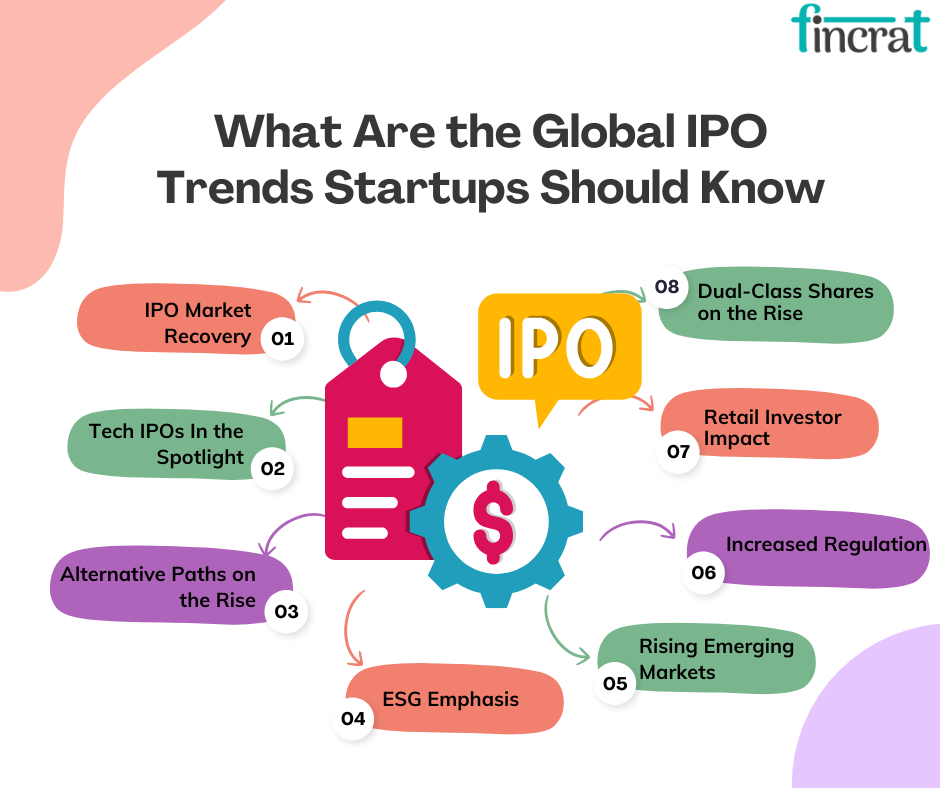
- IPO Market Recovery: Following a decline in 2022–2023, IPO markets are recovering in 2024–2025, particularly in tech and clean energy companies. Timing is still important.
- Tech IPOs In the Spotlight: Investors now expect good fundamentals, not necessarily growth. Profitability and good revenue models are key to tech IPOs.
- Alternative Paths on the Rise: SPAC mergers and direct listings provide quicker or more convenient public-market access—but entail other risks and needs.
- ESG Emphasis: ESG conformity is increasingly becoming a valuation criterion, particularly in Asia and Europe. Startups need to prepare ESG disclosures well in advance.
- Rising Emerging Markets: IPO activity is surging in the Middle East, Southeast Asia, and India, presenting new opportunities beyond the U.S. core markets.
- Increased Regulation: Regulators worldwide now require greater transparency, independence of boards, and cybersecurity requirements. Preparation for an IPO is more involved and time-consuming.
- Retail Investor Impact: Retail investors are more engaged because of trading platforms. Public opinion and brand influence IPO demand and post-listing success.
- Dual-Class Shares on the Rise: Founders are more making use of dual-class shares to maintain control, but governance issues need to be resolved.
Final Thoughts: IPOs Are Milestones, Not Endpoints
An Initial Public Offering (IPO) is a defining achievement in a startup's journey, but it is not the final destination. Rather than viewing it as the conclusion of years of effort, founders should recognize an IPO as a new beginning—one that opens the door to increased capital, scrutiny, and responsibility.
Going public means joining a highly visible, regulated ecosystem where performance is tracked in real-time, investors demand results, and market conditions influence perception and valuation.
To thrive in this environment, startups must shift from a growth-at-any-cost mindset to one rooted in sustainable strategy, transparency, and stakeholder alignment.
The companies that succeed post-IPO are those that continue to innovate, communicate effectively with shareholders, and manage their public image while staying true to their mission. Ultimately, an IPO is not the finish line—it’s the start of a new race.
“In today’s world, an IPO isn’t just an exit—it’s an entrance into a higher league of growth, governance, and global trust.”

